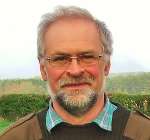Can a performance have ever been so keenly anticipated? The Edinburgh International Festival’s Ring Cycle in concert performance began promisingly three years ago with Valery Gergiev’s Das Rheingold followed by an epic Die Walküre from Sir Andrew Davis and the RSNO. Mark Elder and the Hallé brought its heroic Siegfried to Edinburgh last year, but it is still that astonishing Walküre that is talked about. There was a palpable crackle of expectation in the packed Usher Hall as Davis and the RSNO with Christine Goerke as Brünnhilde returned to finish the cycle with Götterdämmerung, the fiery finale.
The RSNO filled the platform, powerhouse cellos centre stage, violins left and right, but it was the double timpani and the two rows of horns that caught the eye with the six golden harps resplendently towering over everything at the front of the organ gallery. This is an orchestra which does not get to play full operas very often, the players bringing joyful discovery and a freshness to the music, rising magnificently to the challenge drawing us straight back into the Ring’s themes from the very first bars as the Norns entered to reprise the story so far, luxury casting from Ronnita Miller, Karen Cargill and Erin Wall sounding wonderful.
Davis, now in his mid-seventies, sat on a stool to conduct most of Walküre, but was on his feet for the entirety of this performance drawing wondrous storytelling from the players, keeping the work moving steadily along. The orchestral interludes, the Rhine Journey and Siegfried’s Funeral Music were transformative, the thrilling “earworm” leitmotifs cascading through the work, but Davis worked on light and shade, turning from magisterial to heart-breaking compassion in a moment. Strings were the hardworking, honest backbone, illustrated with beautiful woodwind solo work, but it was the brass that stole the show. Nine onstage horns, four more offstage and additional steerhorn players were completely pivotal to the music, playing as if their lives depended on it, their gossamer soft entries were as effective as their burnished punchiness was striking. The heavy brass added the necessary Wagnerian weight and I enjoyed the bass trumpet’s unusual colouring.
Christine Goerke, surely the festival’s favourite Brünnhilde, gave an absolutely immense performance, full of power yet vulnerable, using her tight performing space to maximum dramatic advantage. So passionate was her love for Siegfried, her affront on being tricked was even more deeply heartfelt. The undoubted high point of the entire evening was the mesmerising scene between Brünnhilde and Waltrute, Cargill returning to the stage on powerfully dramatic form, her gorgeous mezzo oozing weighty authority. The scene moved from warm sisterly hugs to a sad detachment as Cargill’s vivid description of the gods in despair hit home as she told of Wotan waiting in diminishing hope for his ravens to deliver crumbs of good news. It was a wonderful moment from this Wagnerian dream team.
In the Hall of the Gibichungs, Ain Anger was a thoughtful Hagen, a solid voice weighing up his next moves and outwitting Gutrune and Gunter, the pair beautifully sung by Amber Wagner and Josef Wagner, the RCS Voices adding energy and depth. As a Siegfried newcomer, Burkhard Fritz’s silvery tenor shone through, sometimes variable but always honest, tiring a little towards the end as he recalled the Woodbird’s message. Samuel Youn returned to reprise his role as Alberich, a splendidly evil performance. The three Rhinemaidens, Danae Kontora, Edinburgh’s own Catriona Morrison and late stand-in Claudia Huckle blended beautifully, mischievously teasing Siegfried mercilessly to try to secure the Ring.
This performance really took off vocally when the singers came off their scores and were able to act. Concert versions of operas are a strange halfway house, but I felt the action became somewhat two dimensional when some of the singers remained tethered to their music stands for too long.
The EIF’s Ring cycle has been a wonderful experience over the four years, a tremendous achievement with the three different orchestras and hand-picked international casts. For me, it has been a thrill to watch the orchestras create this wonderful music before our eyes, a rare visual lesson in how the Ring is constructed, a secret normally hidden in the depths of the pit. This performance of Götterdämmerung was a fabulous end to Edinburgh’s memorable Ring, Goerke’s final bow bringing the hall to its feet. Tickets for this performance were snapped up early, but happily it was recorded for broadcast for those not able to be there.




